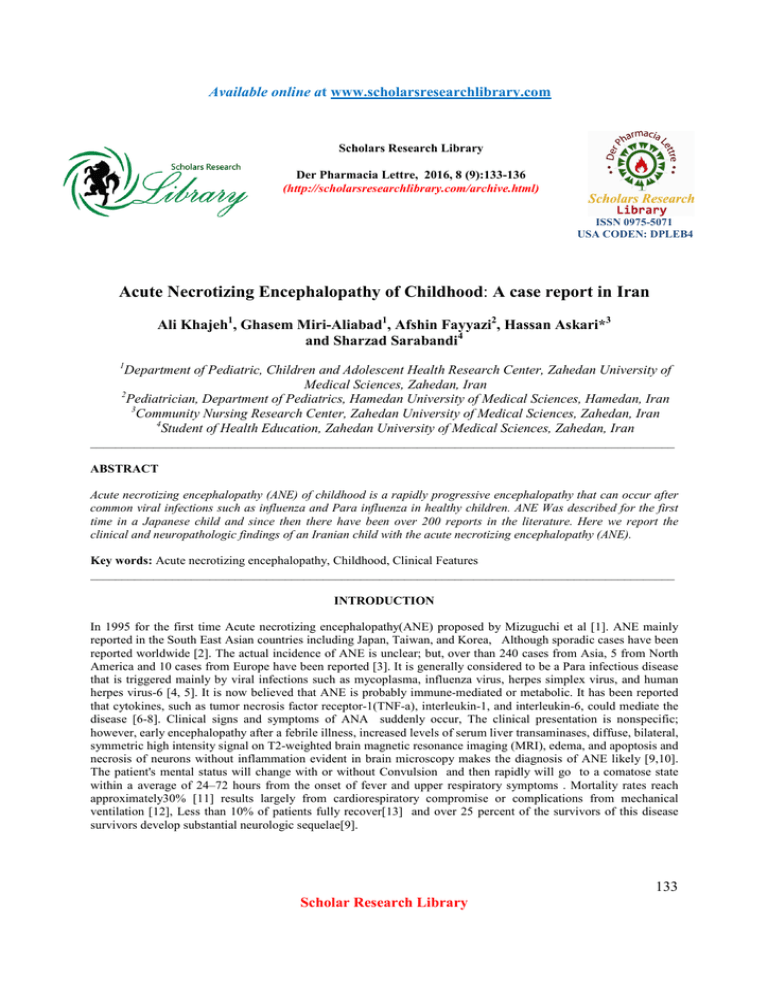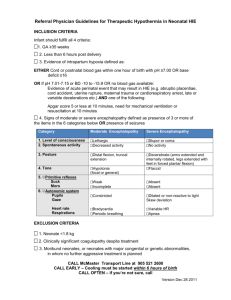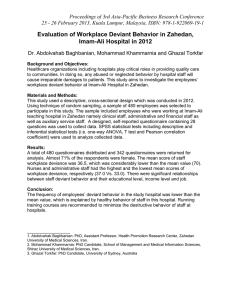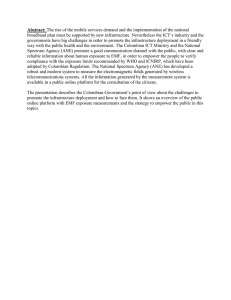Acute Necrotizing Encephalopathy of Childhood: A case report in Iran
advertisement

Available online at www.scholarsresearchlibrary.com Scholars Research Library Der Pharmacia Lettre, 2016, 8 (9):133-136 (http://scholarsresearchlibrary.com/archive.html) ISSN 0975-5071 USA CODEN: DPLEB4 Acute Necrotizing Encephalopathy of Childhood: A case report in Iran Ali Khajeh1, Ghasem Miri-Aliabad1, Afshin Fayyazi2, Hassan Askari*3 and Sharzad Sarabandi4 1 Department of Pediatric, Children and Adolescent Health Research Center, Zahedan University of Medical Sciences, Zahedan, Iran 2 Pediatrician, Department of Pediatrics, Hamedan University of Medical Sciences, Hamedan, Iran 3 Community Nursing Research Center, Zahedan University of Medical Sciences, Zahedan, Iran 4 Student of Health Education, Zahedan University of Medical Sciences, Zahedan, Iran _____________________________________________________________________________________________ ABSTRACT Acute necrotizing encephalopathy (ANE) of childhood is a rapidly progressive encephalopathy that can occur after common viral infections such as influenza and Para influenza in healthy children. ANE Was described for the first time in a Japanese child and since then there have been over 200 reports in the literature. Here we report the clinical and neuropathologic findings of an Iranian child with the acute necrotizing encephalopathy (ANE). Key words: Acute necrotizing encephalopathy, Childhood, Clinical Features _____________________________________________________________________________________________ INTRODUCTION In 1995 for the first time Acute necrotizing encephalopathy(ANE) proposed by Mizuguchi et al [1]. ANE mainly reported in the South East Asian countries including Japan, Taiwan, and Korea, Although sporadic cases have been reported worldwide [2]. The actual incidence of ANE is unclear; but, over than 240 cases from Asia, 5 from North America and 10 cases from Europe have been reported [3]. It is generally considered to be a Para infectious disease that is triggered mainly by viral infections such as mycoplasma, influenza virus, herpes simplex virus, and human herpes virus-6 [4, 5]. It is now believed that ANE is probably immune-mediated or metabolic. It has been reported that cytokines, such as tumor necrosis factor receptor-1(TNF-a), interleukin-1, and interleukin-6, could mediate the disease [6-8]. Clinical signs and symptoms of ANA suddenly occur, The clinical presentation is nonspecific; however, early encephalopathy after a febrile illness, increased levels of serum liver transaminases, diffuse, bilateral, symmetric high intensity signal on T2-weighted brain magnetic resonance imaging (MRI), edema, and apoptosis and necrosis of neurons without inflammation evident in brain microscopy makes the diagnosis of ANE likely [9,10]. The patient's mental status will change with or without Convulsion and then rapidly will go to a comatose state within a average of 24–72 hours from the onset of fever and upper respiratory symptoms . Mortality rates reach approximately30% [11] results largely from cardiorespiratory compromise or complications from mechanical ventilation [12], Less than 10% of patients fully recover[13] and over 25 percent of the survivors of this disease survivors develop substantial neurologic sequelae[9]. 133 Scholar Research Library Hassan Askari et al Der Pharmacia Lettre, 2016, 8 (9):133-136 ______________________________________________________________________________ The diagnosis of ANE is primarily based on neuro-radiological findings, radiological reports show symmetric lesions in the thalami, with variable involvement of the white matter, basal ganglia, brainstem, and cerebellum[14,15]. Here, we report a child with acute neurological symptoms resulted by a possible infection process and explain their CT-scan and brain MRI as well as Para clinical symptoms. According to our survey, this is one of the first cases of acute necrotizing encephalopathy reported in Iran. CASE REPORT: The patient was a male infant, with an unremarkable history, developed a febrile illness (temperature 38.5 c) at 5 months of age, followed by general deterioration. A decreased level of consciousness (GCS=12-13). Physical examination showed normal fontanels, slightly hypotonia. He was transferred from khash hospital to ali ibn abitaleb hospital in zahedan. At beginning of hospitalization he had BP=90/55, PR=125, RR=32, T=38.5. On the first day admission, routine laboratory investigation was normal. Aspartate aminotransferase 147 u/l (normal value to 40), alanine aminotransferase 480 u/l ( normal value up to 40 ), blood count was normal as were coagulation studies, Base deficit ,urea, creatinine. All metabolic studies including serum and urine amino acid chromatography, urine reducing substances as well as the measurement of the blood ammonia and lactate, acylcarnitine profile and fatty acids metabolism disorder were all normal. CSF analysis include protein=250mg/dl, WBC, RBC= 0, sugar 57mg/dl. CT scan showed hypodensity in both thalami. Brain MRI showed increased signal in T1 and T2 weighted images on both thalami. Treatment was with corticosteroeid (30mg/kg/day) in 3 days. The child improved progressively, with loss of fever on 2 days, and recovery of conscious on 5 days and he was discharged. Fig 1.thalamus lesion in ANEC in Brain MRI DISCUSSION ANE is a rare disease as observed in the children who have been already healthy and mainly affects infants and young children in East Asia, though its sporadic cases were found throughout the world. ANE symptoms will progress quickly. Symptoms include cough, vomiting and diarrhea in combination with neurologic dysfunction including the rapid change in consciousness, convulsions and high mortality[6,16,17]. In more than 90 percent of patients with the ANE, a prodromal febrile disease has been reported and in some patients is documented a concurrent diseases, such as influenza A, influenza B, human herpes virus(HHV)-6, mycoplasma pneumonia, herpes simplex, or measles infection[4,18]. In our report, the patiant have a prodromal febrile disease with the low level of consciousness. The initial signs of the patient suggest viral gastroenteritis. The major biochemical disturbances expressed in acute necrotizing encephalopathy of childhood are metabolic acidosis, elevated of serum aspartate aminotransferase and creatine kinase [13], all of which were present in this case. In ANE, laboratory studies show high levels of protein of cerebrospinal fluid without pleocytosis[13,19]. But in our report the protein content in cerebrospinal fluid was normal. Radiological symptoms in ANEC are specific and diagnostic including symmetrical and multifocal involvement in thalamus, brainstem, supratentorial white matter and cerebellum. These lesions initially show low attenuation on CT and T1/T2 prolongation on MR studies, later evolving into concentric lesions with a central area of hemorrhage that appears hyperdense on CT or hyperintense on T1-weighted MRI images. Contrast enhancement around the area of 134 Scholar Research Library Hassan Askari et al Der Pharmacia Lettre, 2016, 8 (9):133-136 ______________________________________________________________________________ hemorrhage becomes apparent by 2 weeks and cavitation occurs in 50 percent of lesions. Areas of diffusion restriction within acute lesions have been described [6, 7, 15, 16, and 20]. In our report CT scan showed hypodensity in both thalami. Brain MRI showed increased signal in T1 and T2 weighted images on both thalami(fig 1 and 2). The mortality and morbidity of this disease is high, and survivors of the disease at least show a short term neurological complications[12] in our report patient was discharge from the hospital without any problem. Fig2. BILATERAL thalamus involvement in MRI In conclusion, we described the clinical and neuropathologic findings of an Iranian child with acute necrotizing encephalopathy of childhood. This case is one of the first to be reported in Iran. After short viral diseases that is associated with rapid neurologic deterioration, the diagnosis of acute necrotizing encephalopathy of childhood should be considered. Since magnetic resonance imaging show radiologic findings that are specific in acute necrotizing encephalopathy, thus MRI is a useful way to early diagnosis of this disease. Acknowledgements Hereby we thank the Authorities of zahdan ali ibn abitaleb hospital for appreciate this report. Authors’ Contributions All authors had equal role in, work and manuscript writing. Funding/Support This study was supported by Zahdan University of Medical Sciences, Zahdan, Iran. REFERENCES [1] Mizuguchi M, Abe J, Mikkaichi K, Noma S, Yoshida K, Yamanaka T, et al. Journal of Neurology, Neurosurgery & Psychiatry. 1995;58(5):555-61. [2] Kim KJ, Park ES, Chang HJ, Suh M, Rha D-W. Annals of rehabilitation medicine. 2013;37(2):286-90. [3] Mastroyianni SD, Gionnis D, Voudris K, Skardoutsou A, Mizuguchi M. Journal of child neurology. 2006;21(10):872-9. 135 Scholar Research Library Hassan Askari et al Der Pharmacia Lettre, 2016, 8 (9):133-136 ______________________________________________________________________________ [4] Wu X, Wu W, Pan W, Wu L, Liu K, Zhang H-L. Acute Necrotizing Encephalopathy: An Underrecognized Clinicoradiologic Disorder. Mediators of inflammation. 2015;2015. [5] Salehiomran Mr, Nooreddini H, Baghdadi F. Iranian Journal of Child Neurology. 2013;7(2):51. [6] Wong A, Simon E, Zimmerman R, Wang H-S, Toh C-H, Ng S-H. American journal of neuroradiology. 2006;27(9):1919-23. [7] Lyon JB, Remigio C, Milligan T, Deline C. Pediatric radiology. 2010;40(2):200-5. [8] Neilson DE, Adams MD, Orr CM, Schelling DK, Eiben RM, Kerr DS, et al. The American Journal of Human Genetics. 2009;84(1):44-51. [9] Kim Y-N, You SJ. Korean journal of pediatrics. 2012;55(4):147-50. [10] Goo HW, Choi C-G, Yoon CH, Ko T-S. Korean Journal of Radiology. 2003;4(1):61-5. [11]Marco EJ, Anderson JE, Neilson DE, Strober JB. Pediatrics. 2010;125(3):e693-e8. [12] Martin A, Reade EP. Clinical Infectious Diseases. 2010;50(8):e50-e2. [13] San Millan B, Teijeira S, Penin C, Garcia JL, Navarro C. Pediatric neurology. 2007;37(6):438-41. [14] Seo H-E, Hwang S-K, Choe BH, Cho M-H, Park S-P, Kwon S. Journal of Korean medical science. 2010;25(3):449-53. [15] Mizuguchi M, Hayashi M, Nakano I, Kuwashima M, Yoshida K, Nakai Y, et al. Neuroradiology. 2002;44(6):489-93. [16] Ohsaka M, Houkin K, Takigami M, Koyanagi I. Pediatric neurology. 2006;34(2):160-3. [17] Weitkamp J-H, Spring MD, Brogan T, Moses H, Bloch KC, Wright PF. The Pediatric infectious disease journal. 2004;23(3):259-63. [18] Ouattara LA, Barin F, Barthez MA, Bonnaud B, Roingeard P, Goudeau A, et al. Emerging infectious diseases. 2011;17(8):1436. [19] Skelton BW, Hollingshead MC, Sledd AT, Phillips CD, Castillo M. Pediatric radiology. 2008;38(7):810-3. [20] Okumura A, Mizuguchi M, Kidokoro H, Tanaka M, Abe S, Hosoya M, et al. Brain and Development. 2009;31(3):221-7. 136 Scholar Research Library







